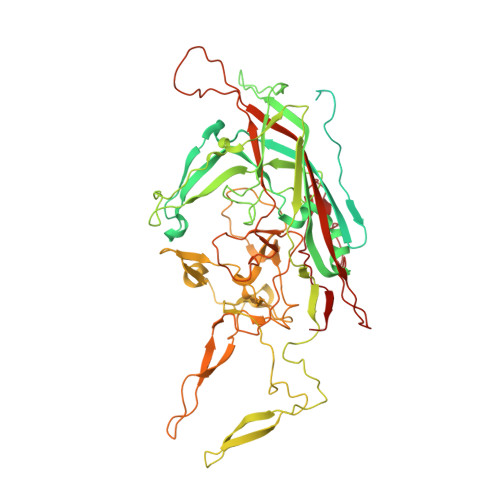Cross-Species Permissivity: Structure of a Goat Adeno-Associated Virus and Its Complex with the Human Receptor AAVR.
Large, E.E., Silveria, M.A., Weerakoon, O., White, T.A., Chapman, M.S.(2022) J Virol 96: e0148422-e0148422
- PubMed: 36453885
- DOI: https://doi.org/10.1128/jvi.01484-22
- Primary Citation of Related Structures:
7TI4, 7TI5 - PubMed Abstract:
Adeno-associated virus (AAV) is a small ssDNA satellite virus of high interest (in recombinant form) as a safe and effective gene therapy vector. AAV's human cell entry receptor (AAVR) contains polycystic kidney disease (PKD) domains bound by AAV. Seeking understanding of the spectrum of interactions, goat AAVGo.1 is investigated, because its host is the species most distant from human with reciprocal cross-species cell susceptibility. The structure of AAVGo.1, solved by cryo-EM to 2.9 Å resolution, is most similar to AAV5. Through ELISA (enzyme-linked immunosorbent assay) studies, it is shown that AAVGo.1 binds to human AAVR more strongly than do AAV2 or AAV5, and that it joins AAV5 in a class that binds exclusively to PKD domain 1 (PKD1), in contrast to other AAVs that interact primarily with PKD2. The AAVGo.1 cryo-EM structure of a complex with a PKD12 fragment of AAVR at 2.4 Å resolution shows PKD1 bound with minimal change in virus structure. There are only minor conformational adaptations in AAVR, but there is a near-rigid rotation of PKD1 with maximal displacement of the receptor domain by ~1 Å compared to PKD1 bound to AAV5. AAVGo.1 joins AAV5 as the second member of an emerging class of AAVs whose mode of receptor-binding is completely different from other AAVs, typified by AAV2. IMPORTANCE Adeno-associated virus (AAV) is a small ssDNA satellite parvovirus. As a recombinant vector with a protein shell encapsidating a transgene, recombinant AAV (rAAV) is a leading delivery vehicle for gene therapy, with two FDA-approved treatments and 150 clinical trials for 30 diseases. The human entry receptor AAVR has five PKD domains. To date, all serotypes, except AAV5, have interacted primarily with the second PKD domain, PKD2. Goat is the AAV host most distant from human with cross-species cell infectivity. AAVGo.1 is similar in structure to AAV5, the two forming a class with a distinct mode of receptor-binding. Within the two classes, binding interactions are mostly conserved, giving an indication of the latitude available in modulating delivery vectors.
- Department of Biochemistry, University of Missourigrid.134936.a, Columbia, Missouri, USA.
Organizational Affiliation:
















